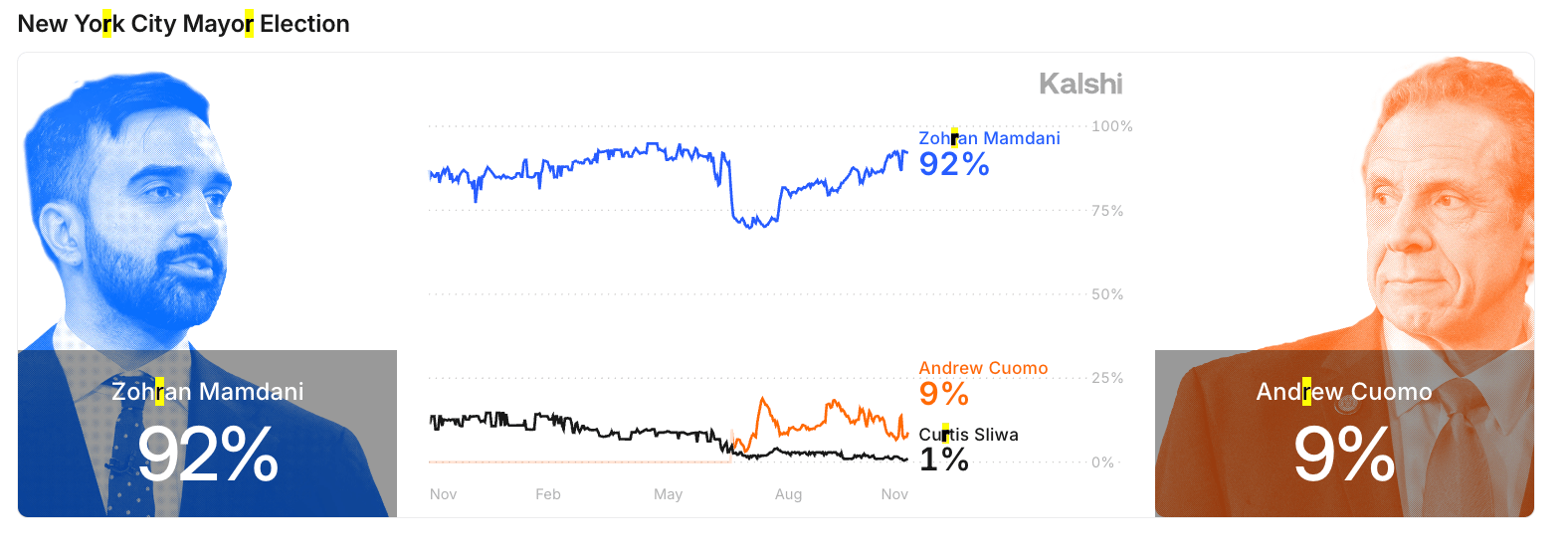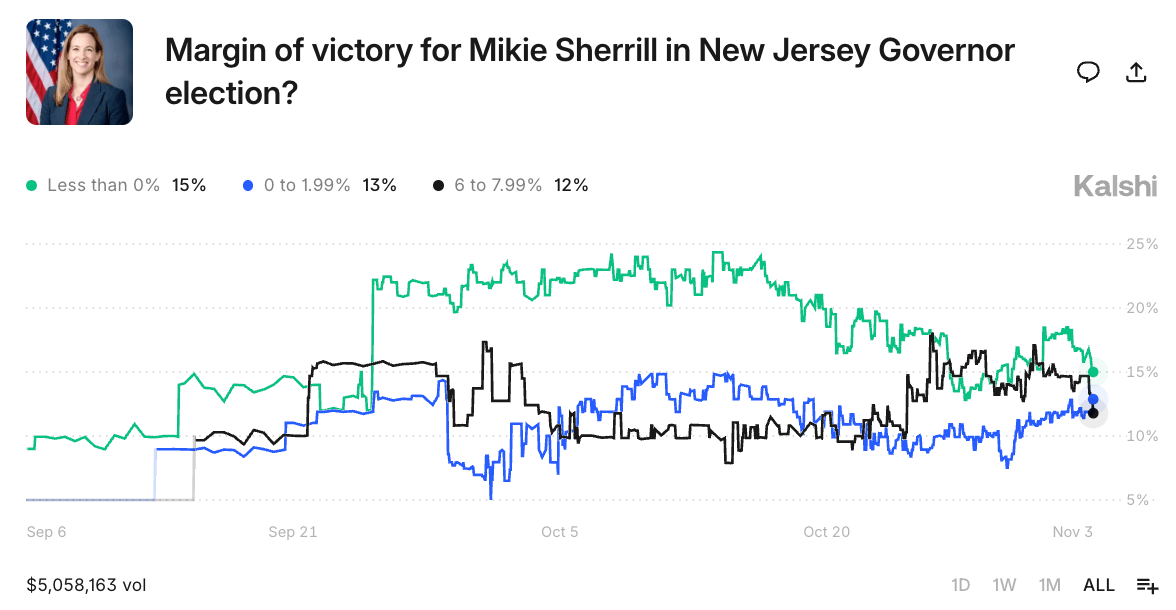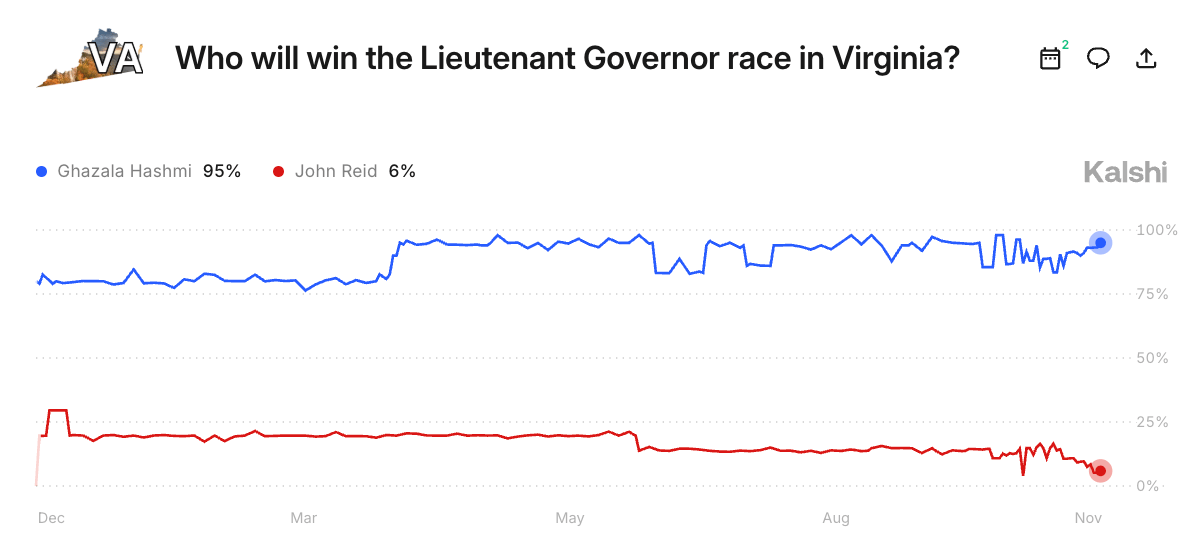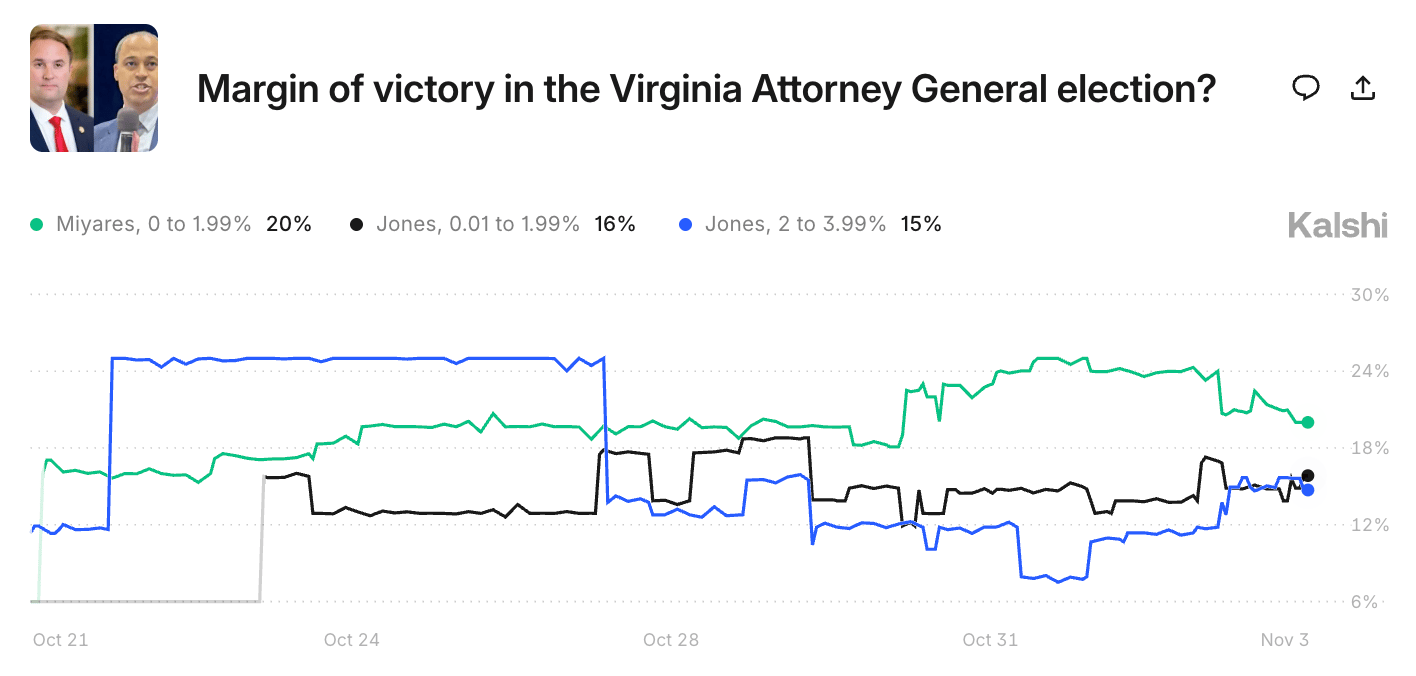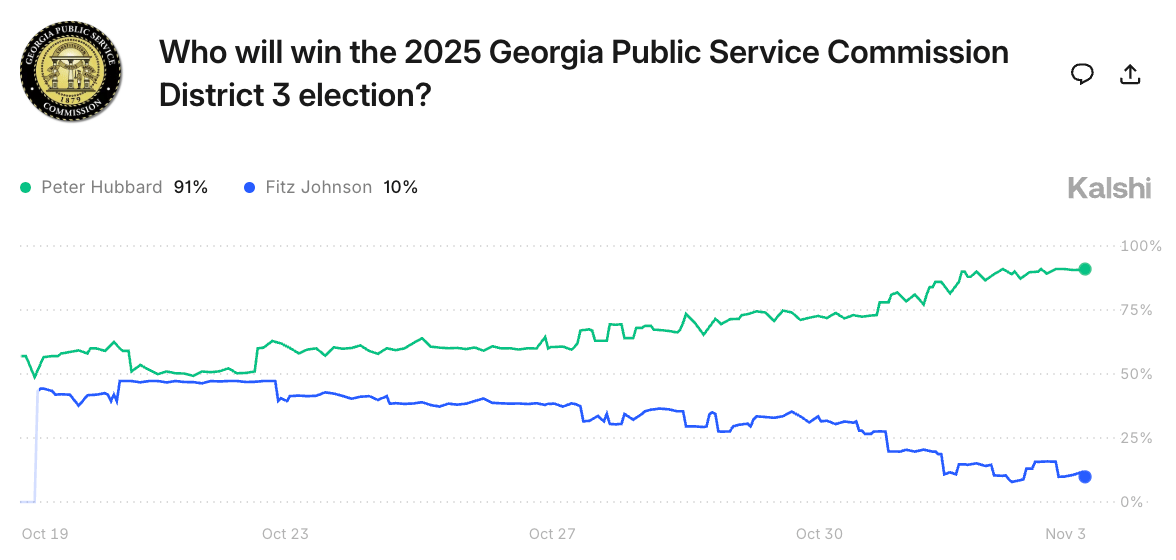In the fall of 2024, traditional media outlets and political pollsters tried to paint the upcoming presidential election as a tight race. But on Kalshi, where people were legally trading on elections for the first time in over 100 years, the story was quite different, with Donald Trump as the clear favorite.
Sure enough, on Election Night, Kalshi’s markets indicated Trump was the winner hours before the press made the call.
As professor and prediction market expert Koleman Strumpf put it:
I called my parents at 8:30, and I told them, “Donald Trump’s the next president.” They were busy being good citizens watching [cable news], and, you know, [it] told them nothing. That’s also pretty typical. If you want to know what’s happening that night, you look at the markets.
It’s been said that the definition of insanity is doing the same thing over and over and expecting different results. So if you’re still watching cable-news pundits and know-nothing internet influencers for election coverage, it’s time to switch to Kalshi’s 2025 Election Hub and see what’s really happening in real time.
Kalshi’s 2025 Election Hub offers a real-time window into elections across the country. It’s the fastest, clearest way to watch the results unfold as markets react before the headlines are written. It’s destined to become your second-favorite hub on the Internet.
With that in mind, let’s take a look at what Kalshi’s election markets are currently forecasting for today’s biggest races. And remember to check back throughout the day to watch the drama unfold in real time.
New York City Mayoral Election
Perhaps the marquee race of 2025, the three-way contest to lead America’s largest city hurtles to a close on Tuesday. The three candidates still in the race are Democratic nominee Zohran Mamdani, the Republican nominee Curtis Sliwa, and former New York governor Andrew Cuomo, who is running for mayor as an independent after losing the Democratic primary to Mamdani back in June.
While New York City has had Republican and independent mayors this century, it is still a deeply Democratic city and in the past decade mayoral general elections have typically been blowout affairs, with Democrats winning against Republicans by margins of 40% or more. But this year’s roller coaster election has been anything but typical.
In the Democratic primary, the 33-year-old Mamdani – a proud Democratic Socialist – made national headlines when he defeated Cuomo, long the favorite in the polls. That stunning upset threw the general election into chaos. Initially the general election was a four-way race, with Eric Adams, the incumbent mayor of NYC, also running as an independent. But in late September, Adams (lagging in polls and fundraising) dropped out of the race and ultimately endorsed Cuomo after the general election debates in October.
Heading into Tuesday, Mamdani maintains a strong advantage in the race, which is reflected in our market. The polling has remained remarkably stable in the election, with Mamdani’s vote share in the mid 40s, Cuomo’s in the low 30s, and Sliwa’s in the teens. The fact that Mamdani has not been able to consistently hit 50% has spurred immense pressure on Sliwa to drop out (with the presumption that his supporters would vote for Cuomo instead), but Sliwa has remained steadfast in his decision to remain in the race. Initial early voting showed a surge in older voters, which would most likely benefit Cuomo, but in the week since younger voters have closed the gap and now surpassed their turnout % in the 2021 mayoral election.
Apart from the question of who will emerge victorious, Mamdani’s margin of victory and his ultimate vote share are also key areas to watch. Will his win be a landslide or a squeaker? Will he be able to hit 50% and claim a mandate for his vision? It will also be interesting to see where each candidate’s areas of strength are in the city; can Mamdani make inroads with voters in both the tony Upper East Side as well as working class Bronx neighborhoods? Whatever happens, the results of this vote will provide a preview of battle lines in 2026 – and the future of the Democratic Party.
New Jersey Gubernatorial Election
A traditionally blue state that saw an over 10-point shift to Trump in 2025, New Jersey is home to perhaps the most competitive governor's race this fall. Two candidates are vying to replace outgoing two-term Democratic governor Phil Murphy: Democrat Mikie Sherrill and Republican Jack Ciattarelli.
Sherrill, a Congresswoman, currently represents New Jersey’s 11th congressional district in the New York City suburbs. A former Navy helicopter pilot and federal prosecutor, Sherrill first won election in 2018 by flipping a Trump +1 district by 14 points. Earlier this year, she emerged from a crowded Democratic primary, defeating Newark mayor Ras Baraka and Jersey City mayor Steve Fulop.
The Republican nominee is former New Jersey State Representative Jack Ciattarelli, who is running for the governor’s mansion for a second time after narrowly losing to governor Phil Murphy in 2021 by about 3 points. Ciattarelli swept to victory in the GOP primary with nearly 70% of the vote after securing President Trump’s endorsement.
Although Harris did win New Jersey by around 6 points in 2024, this race has become highly competitive, with multiple polls in the last few months showing a tossup race or a race within the margin of error. Part of this is undoubtedly the challenge of trying to convince voters to elect a Democratic governor for a third straight term, since Murphy’s middling approvals create a ripe environment for voters to prioritize a change in the upcoming election – something that Ciattarelli has sought to capitalize on.
Sherrill has also been hampered by negative headlines during the past few months, including questions about her personal finances and wealth accrued during her time in Congress and the fact that she did not walk with her classmates at the Naval Academy graduation as a result of a massive cheating scandal. As a result, Ciattarelli’s chances surged from 12% to 24% in early October before settling just below 20% on the eve of the election.
Now, traders still forecast a likely Sherrill victory, but something to watch will be her margin of victory. Can she match Harris’ margin of just under 6%, or will the race be a nail-biter the same way it was four years ago? On the other hand, if Sherrill can significantly outrun Harris, perhaps even winning by double digits, it could indicate that Trump’s gains in the northeastern states may be difficult for the GOP to replicate without him on the ticket. New Jersey is also home to many Hispanic communities that stampeded over 30 points toward Trump between 2020 and 2024 – some of which can be found in counties like Passaic. Democratic margins in these towns and counties will also provide key indicators as to the party’s fortunes in key battleground districts and states in 2026.
Virginia Elections
Another state with a competitive gubernatorial election, Virginia will have an entire slate of closely-watched statewide races on Tuesday, as well as control of its 100-member House of Delegates (the lower house in the General Assembly) up for grabs. At the federal level, Virginia has consistently voted for Democrats since 2008, with Harris winning the state in 2024 by around 5.8%. However, it also currently has a Republican governor, lieutenant governor, and attorney general who all won in 2021. Democrats, meanwhile, hold a narrow 51-49 majority in the Virginia House of Delegates. Here are the key things to keep in mind going into Election Day:
Virginia Governor:
Due to a unique state constitutional provision that bans its governors from serving consecutive terms (a limit which does not exist for the LG or AG roles), current GOP Governor Glenn Youngkin cannot seek reelection, making this an open seat election.
Seeking to reclaim the governor’s mansion for Democrats is former Virginia Congresswoman Abigail Spanberger, who represented Virginia’s 7th District in Congress. She was first elected during the 2018 “blue wave” and won multiple competitive elections in districts that were centered first around Richmond and then (after the 2020 redistricting cycle) the Northern Virginia suburbs.
The Republican nominee for governor is the state’s current lieutenant governor, Winsome Earle-Sears. She was elected as lieutenant governor in 2021 as part of the red wave that swept in Governor Glenn Youngkin and Attorney General Jason Miyares, making history as the first woman of color to win and hold statewide office in Virginia.
At first glance, this election has the elements on paper to be highly competitive given Virginia’s recent history of electing both Democratic and Republican governors. While it does have a slight blue lean, Youngkin’s election shows that is by no means an insurmountable partisan advantage. However, the polling has consistently shown Spanberger leading by anywhere from 8 to 12 points, and traders believe that Spanberger is heavily favored in tomorrow’s vote. Virginia has typically elected governors from the party out of power in the White House, and Spanberger’s fundraising strength relative to Earle-Sears has boosted her throughout the campaign. Virginia is also home to hundreds of thousands of federal workers, who have been negatively impacted by Elon Musk’s DOGE cuts earlier in the year and by the current government shutdown, for which Republicans have generally taken more blame.
Given these structural and circumstantial headwinds working against Earle-Sears, the biggest question outstanding may not be whether Spanberger wins, but by how much – a question that has important ramifications for downballot elections.
Virginia Lieutenant Governor:
Also on the ballot is the lieutenant governor, the second in command in the state government. On the Democratic side, state senator Ghazala Hashmi won an extremely close three-way primary election in June to clinch the nomination. On the Republican side, conservative radio host John Reid emerged victorious from the Republican convention (the Virginia GOP selects non-federal statewide office nominees via a nominating convention of party delegates rather than a statewide primary). Reid is the first openly gay man nominated for statewide office by the GOP.
Since then, this race has been relatively quiet, with the exception of some controversy that swirled around John Reid’s social media usage in the spring and early summer. Hashmi has repeatedly outraised Reid and has maintained a consistent lead over him in the polls; although the lead varies, the data indicates she will slightly underperform Spanberger’s margin. Traders also give Hashmi over a 90% chance of winning the election, with a larger Spanberger victory likely to also help Hashmi prevail.
This, according to traders, is likely to be the closest race of 2025, and it certainly has proven to be the most controversial so far.
This is the only race where Republicans have an incumbent, with Attorney General Jason Miyares, who first won office in 2021 as the first Cuban-American and Hispanic statewide elected official, running for reelection. On the Democratic side, former State Delegate Jay Jones defeated Henrico County prosecutor Shannon Taylor in another close primary race earlier in the year.
But this race was thrust into the national spotlight in October, first when the Richmond Times-Dispatch reported that the Democratic candidate for attorney general, Jay Jones, had been previously convicted of reckless driving in 2022, apparently for driving 116 miles per hour on the interstate. Jones paid a fine and reported that he had performed 1000 hours of community service to the court. However, it was also revealed that 500 of those hours were performed with Jones’ own political action committee, Meet our Moment.
But later that same week, an even bigger bombshell dropped. Extremely disturbing text messages that Jones sent to a GOP member of the House of Delegates came to light, upending the AG race further. In a 2022 text conversation, Jones described a hypothetical scenario where he would shoot Republican Todd Gilbert, the then-Speaker of the Virginia House, in the head.
“Three people, two bullets. Gilbert, hitler, and pol pot. Gilbert gets two bullets to the head.”

Somehow, it only got worse after this. In another part of the text conversation, Jones seemed to wish death on Gilbert’s children so they would feel the anguish of parents whose children died from gun violence. And to cap it off, Jones expressed that the Gilberts were “evil” and that their children were “little fascists.”

The reaction to this was immediate. In a nation still shaken by the assassination of Charlie Kirk, Jones’ violent political rhetoric experienced immediate and immense condemnation from nearly every national and state Republican. Most also demanded that Jones drop out of the AG race in disgrace. National and state Democrats, including Virginia governor and lieutenant governor candidates Abigail Spanberger and Ghazala Hashmi, also condemned Jones’ texts as unacceptable, but did not go as far as to call on him to drop out.
Jones’ odds immediately plummeted in our market, and nearly all polling released after the scandal showed him falling behind Miyares. But in this final week, as undecided voters make up their minds, there are some signs that this race is headed for a photo finish. A pair of new polls show Jones inching ahead of Miyares again, he appeared at a rally with Spanberger and former President Obama to rally the Democratic base, and his odds have surged above 40% once more. This election is the latest to test voters’ willingness to vote for the other party when their own candidate faces a large scandal, and it remains unclear how many Virginians who vote for other Democrats will abandon Jones. If Spanberger wins by a landslide, it may yet be enough to drag Jones over the finish line, for better or worse.
Virginia House of Delegates:
In addition to the three statewide races, there will also be numerous competitive seats in the Virginia House of Delegates, which is the lower house in the state legislature. All 100 seats in the House of Delegates are up for election every two years. Democrats are currently ahead 51-49, but are heavily favored to hold the House and make substantial gains – of the five closest seats in 2023, which were all under a 2% margin, all were won by Republicans.
A statewide swing towards Democrats could conceivably flip all of those seats and more. As Spanberger’s lead has solidified, Democrats have a shot at winning 60 seats – a supermajority – in the House of Delegates. Of course, each seat has its own specific dynamics, with different relative strengths of incumbents vs challengers, but the House of Delegates may remain the most grassroots indication of voters’ preferences and their attitudes toward the second Trump administration.
Other key elections we’re watching:
California Proposition 50:
In response to Texas’ new House maps, which drew out 5 Democratic seats, California Democrats, led by Governor Gavin Newsom, unveiled their own map that likely eliminates 5 Republican seats. For the map to go into effect, voters need to approve it in a statewide referendum on Tuesday. Polls and markets believe that the Proposition will likely pass, which will play a huge role in shaping the battle for the U.S. House next year.
Pennsylvania judicial elections:
Democrats currently hold a 5-2 advantage on Pennsylvania’s state supreme court, which hears cases on everything from voting challenges to abortion access. Three Democratic supreme court justices are up for retention elections, meaning voters will be asked whether to keep them on the bench. Traditionally these elections have been sleepy affairs, but Republicans are making a strong push this year to vote No on retention, potentially flipping the balance of power on the court.
Georgia:
Although lower profile, Georgia has two statewide partisan elections for seats on the Public Service Commission, a board that oversees electricity usage and prices. Aside from rising utility prices being a critical issue on voters’ minds, these represent the first non-federal races in Georgia that Democrats could win in decades – potentially providing a boost to the party before next year’s hotly contested governor’s race and Democratic senator Jon Ossoff’s reelection campaign.
Follow Jaron Zhou on X: @ZhouJaron
Follow Terry Oldreal on X: @realOldTerry
Follow Kalshi on X: @Kalshi
The opinions and perspectives presented in this article belong solely to the author, who is using a pseudonym and cannot trade on Kalshi. This is not financial advice. Trading on Kalshi involves risk and may not be appropriate for all. Members risk losing their cost to enter any transaction, including fees. You should carefully consider whether trading on Kalshi is appropriate for you in light of your investment experience and financial resources. Any trading decisions you make are solely your responsibility and at your own risk. Information is provided for convenience only on an "AS IS" basis. Past performance is not necessarily indicative of future results. Kalshi is subject to U.S. regulatory oversight by the CFTC.


